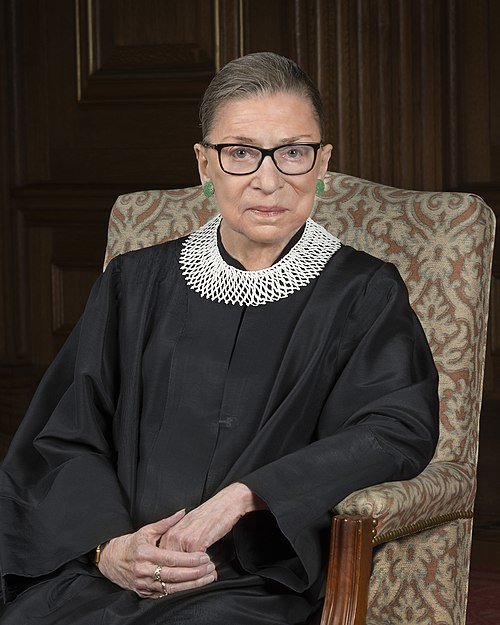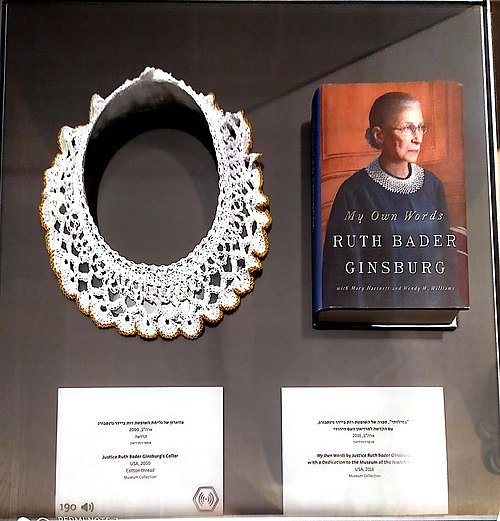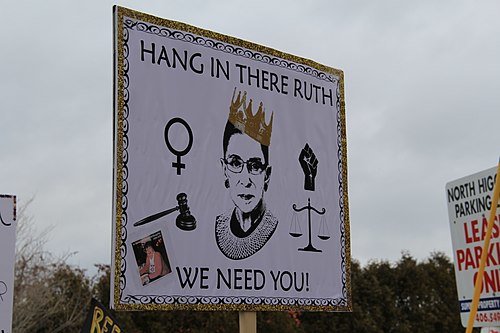מורשת גדולי האומה
בזכותם קיים
beta
Ruth Bader Ginsburg: A Trailblazing Jurist
Ruth Bader Ginsburg, born Joan Ruth Bader on March 15, 1933, and passing away on September 18, 2020, was a Jewish-American jurist who served as an Associate Justice of the Supreme Court of the United States from her appointment by President Bill Clinton in August 1993 until her passing.
She was the second woman to serve on the Supreme Court, following Sandra Day O'Connor. Before her tenure on the Supreme Court, Ginsburg was a professor at Columbia University, a co-founder of the Women's Rights Project at the American Civil Liberties Union (ACLU), and she also served as a judge on the United States Court of Appeals for the District of Columbia Circuit.
Early Life:
Ginsburg was born as Joan Ruth Bader in Brooklyn, New York, into a Jewish conservative family. Her father, Nathan, immigrated to the United States from Odessa, which was then part of the Russian Empire. Her mother, Celia (née Amster), came from Kraków, which was part of the Austro-Hungarian Empire. Tragically, when Ginsburg was just 14 months old, her six-year-old sister died of meningitis. The family was closely associated with the East Midwood Jewish Center, a prominent conservative Jewish center in Brooklyn, where Ginsburg became an active member at the age of 13, participating in the summer camp Che-Na-Wah in Minerva, New York.
Her mother played a significant role in her education, taking her to the library regularly. Ginsburg attended James Madison High School in Brooklyn, and interestingly, the school's law department was later named the "Ginsburg Court" in her honor. During high school, she battled cancer, and tragically, her mother passed away the day before her high school graduation.
On June 23, 1954, Ginsburg graduated with a bachelor's degree in government from Cornell University in Ithaca, New York. Shortly thereafter, she married Martin D. Ginsburg (Marty), who would later become a prominent tax attorney and professor of law.
Legal Education and Career:
In the fall of 1956, Ginsburg began her studies at Harvard Law School, where she was one of only nine women in a class of about 500 students. When her husband accepted a job in New York City, she transferred to Columbia Law School and graduated there with distinction in 1959.
Academic Career:
From 1961 to 1963, Ginsburg served as a research associate and later as a project associate at Columbia Law School's Project on International Procedure. During this time, she also learned Swedish to co-author a book on civil procedure in Sweden with Anders Bruzelius.
From 1963 to 1972, she served as a professor of law at Rutgers University. In 1970, she was one of the co-founders of the Women's Rights Law Reporter, the first law journal in the United States dedicated to women's rights.
From 1972 to 1980, Ginsburg taught at Columbia University, becoming the first woman to receive tenure at the law school. During this period, she also taught law as part of a summer program at Tulane University. Ginsburg was instrumental in shaping anti-discrimination laws based on gender during this time.
In 1977 and 1978, she was a visiting professor at Stanford University, teaching civil procedure as part of the Stanford Law Center's Advanced Studies program.
Ginsburg traveled widely and gave lectures at universities around the world, including Harvard Law School (Fall 1971), the University of Amsterdam (Summer 1975), and the Salzburg Seminar in American Studies (Summer 1984).
Despite a recommendation from the dean of Harvard Law School in 1960, she was initially denied a clerkship position due to her gender. However, she eventually secured a clerkship with Judge Edmund L. Palmieri of the U.S. District Court for the Southern District of New York later that year.
In 1972, Ginsburg co-founded the Women's Rights Project at the American Civil Liberties Union (ACLU) and became its general counsel in 1973. She led the project and argued several cases before the Supreme Court, challenging laws that discriminated against women. Her work helped establish the legal standard of "strict scrutiny" for gender-based discrimination, leading to greater gender equality in the United States.
In June 1980, President Jimmy Carter appointed Ginsburg as a judge on the U.S. Court of Appeals for the District of Columbia Circuit, where she served for 13 years. During her time on the Court of Appeals, she had 57 law clerks, most of whom were women. Later, when she was nominated for the Supreme Court, some criticized her for not having any African American law clerks, alleging racial discrimination. Ginsburg strongly denied these allegations.
Supreme Court Justice:
In 1993, President Bill Clinton nominated Ruth Bader Ginsburg to serve as an Associate Justice of the Supreme Court of the United States, replacing Justice Byron White, who retired. Ginsburg's nomination was recommended by Attorney General Janet Reno. During her confirmation hearings before the Senate Judiciary Committee, Ginsburg declined to answer some questions related to her views on specific legal issues, stating that it would not be appropriate for her to prejudge cases that might come before the Court. This stance caused some controversy, but she was ultimately confirmed by the Senate with a vote of 96-3.
Legacy:
Justice Ruth Bader Ginsburg served on the Supreme Court for nearly three decades, earning a reputation as a staunch advocate for women's rights, gender equality, and civil liberties. She authored numerous notable opinions and dissents, leaving a lasting impact on American jurisprudence. Her work continues to influence legal discussions and shape the trajectory of American law.
Justice Ginsburg's journey from a determined young woman fighting against gender discrimination to becoming a legal trailblazer and a cultural icon is a testament to her resilience, intelligence, and dedication to justice. Her legacy as a pioneering jurist and advocate for equal rights will be remembered for generations to come.
Early Life:
Ginsburg was born as Joan Ruth Bader in Brooklyn, New York, into a Jewish conservative family. Her father, Nathan, immigrated to the United States from Odessa, which was then part of the Russian Empire. Her mother, Celia (née Amster), came from Kraków, which was part of the Austro-Hungarian Empire. Tragically, when Ginsburg was just 14 months old, her six-year-old sister died of meningitis. The family was closely associated with the East Midwood Jewish Center, a prominent conservative Jewish center in Brooklyn, where Ginsburg became an active member at the age of 13, participating in the summer camp Che-Na-Wah in Minerva, New York.
Her mother played a significant role in her education, taking her to the library regularly. Ginsburg attended James Madison High School in Brooklyn, and interestingly, the school's law department was later named the "Ginsburg Court" in her honor. During high school, she battled cancer, and tragically, her mother passed away the day before her high school graduation.
On June 23, 1954, Ginsburg graduated with a bachelor's degree in government from Cornell University in Ithaca, New York. Shortly thereafter, she married Martin D. Ginsburg (Marty), who would later become a prominent tax attorney and professor of law.
Legal Education and Career:
In the fall of 1956, Ginsburg began her studies at Harvard Law School, where she was one of only nine women in a class of about 500 students. When her husband accepted a job in New York City, she transferred to Columbia Law School and graduated there with distinction in 1959.
Academic Career:
From 1961 to 1963, Ginsburg served as a research associate and later as a project associate at Columbia Law School's Project on International Procedure. During this time, she also learned Swedish to co-author a book on civil procedure in Sweden with Anders Bruzelius.
From 1963 to 1972, she served as a professor of law at Rutgers University. In 1970, she was one of the co-founders of the Women's Rights Law Reporter, the first law journal in the United States dedicated to women's rights.
From 1972 to 1980, Ginsburg taught at Columbia University, becoming the first woman to receive tenure at the law school. During this period, she also taught law as part of a summer program at Tulane University. Ginsburg was instrumental in shaping anti-discrimination laws based on gender during this time.
In 1977 and 1978, she was a visiting professor at Stanford University, teaching civil procedure as part of the Stanford Law Center's Advanced Studies program.
Ginsburg traveled widely and gave lectures at universities around the world, including Harvard Law School (Fall 1971), the University of Amsterdam (Summer 1975), and the Salzburg Seminar in American Studies (Summer 1984).
Despite a recommendation from the dean of Harvard Law School in 1960, she was initially denied a clerkship position due to her gender. However, she eventually secured a clerkship with Judge Edmund L. Palmieri of the U.S. District Court for the Southern District of New York later that year.
In 1972, Ginsburg co-founded the Women's Rights Project at the American Civil Liberties Union (ACLU) and became its general counsel in 1973. She led the project and argued several cases before the Supreme Court, challenging laws that discriminated against women. Her work helped establish the legal standard of "strict scrutiny" for gender-based discrimination, leading to greater gender equality in the United States.
In June 1980, President Jimmy Carter appointed Ginsburg as a judge on the U.S. Court of Appeals for the District of Columbia Circuit, where she served for 13 years. During her time on the Court of Appeals, she had 57 law clerks, most of whom were women. Later, when she was nominated for the Supreme Court, some criticized her for not having any African American law clerks, alleging racial discrimination. Ginsburg strongly denied these allegations.
Supreme Court Justice:
In 1993, President Bill Clinton nominated Ruth Bader Ginsburg to serve as an Associate Justice of the Supreme Court of the United States, replacing Justice Byron White, who retired. Ginsburg's nomination was recommended by Attorney General Janet Reno. During her confirmation hearings before the Senate Judiciary Committee, Ginsburg declined to answer some questions related to her views on specific legal issues, stating that it would not be appropriate for her to prejudge cases that might come before the Court. This stance caused some controversy, but she was ultimately confirmed by the Senate with a vote of 96-3.
Legacy:
Justice Ruth Bader Ginsburg served on the Supreme Court for nearly three decades, earning a reputation as a staunch advocate for women's rights, gender equality, and civil liberties. She authored numerous notable opinions and dissents, leaving a lasting impact on American jurisprudence. Her work continues to influence legal discussions and shape the trajectory of American law.
Justice Ginsburg's journey from a determined young woman fighting against gender discrimination to becoming a legal trailblazer and a cultural icon is a testament to her resilience, intelligence, and dedication to justice. Her legacy as a pioneering jurist and advocate for equal rights will be remembered for generations to come.
- רות ביידר גינסבורג – ויקיפדיהhe.wikipedia.org















